Analyzing Business Operations and Human Resources
VerifiedAdded on 2021/04/21
|11
|1895
|31
AI Summary
The provided assignment is a detailed case study of a company's business operations, focusing on its marketing strategies, human resources management, and overall performance. The document explores the company's sales data across different regions and distribution channels, highlighting price variations between years 12 and 13. It also examines the impact of celebrity endorsements on product awareness and revenue growth. Additionally, it reviews the company's remuneration policy, productivity measures, training costs, and employee incentives. The analysis reveals a decrease in productivity despite increased worker motivation and training efforts.
Contribute Materials
Your contribution can guide someone’s learning journey. Share your
documents today.
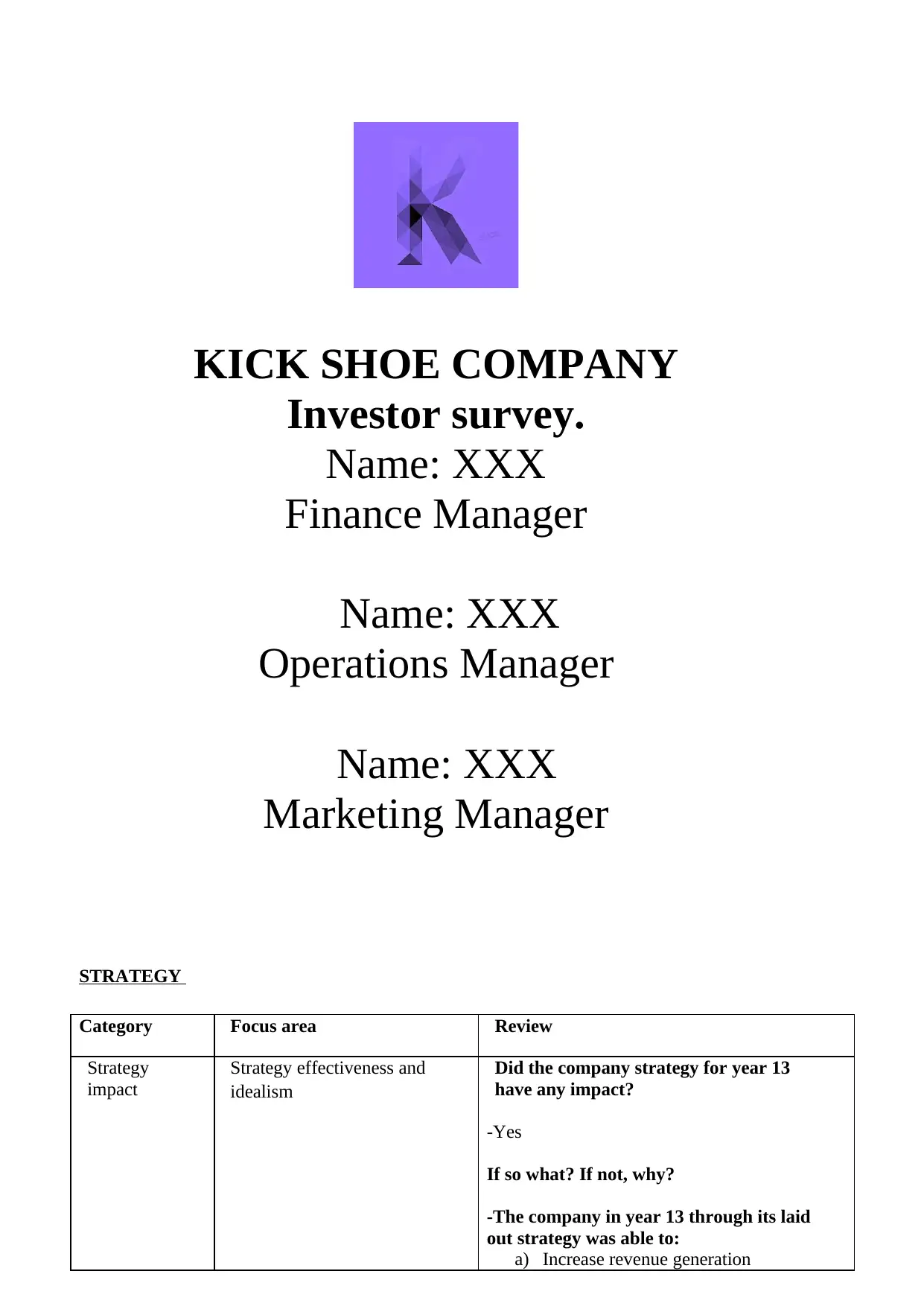
KICK SHOE COMPANY
Investor survey.
Name: XXX
Finance Manager
Name: XXX
Operations Manager
Name: XXX
Marketing Manager
STRATEGY
Category Focus area Review
Strategy
impact
Strategy effectiveness and
idealism
Did the company strategy for year 13
have any impact?
-Yes
If so what? If not, why?
-The company in year 13 through its laid
out strategy was able to:
a) Increase revenue generation
Investor survey.
Name: XXX
Finance Manager
Name: XXX
Operations Manager
Name: XXX
Marketing Manager
STRATEGY
Category Focus area Review
Strategy
impact
Strategy effectiveness and
idealism
Did the company strategy for year 13
have any impact?
-Yes
If so what? If not, why?
-The company in year 13 through its laid
out strategy was able to:
a) Increase revenue generation
Secure Best Marks with AI Grader
Need help grading? Try our AI Grader for instant feedback on your assignments.
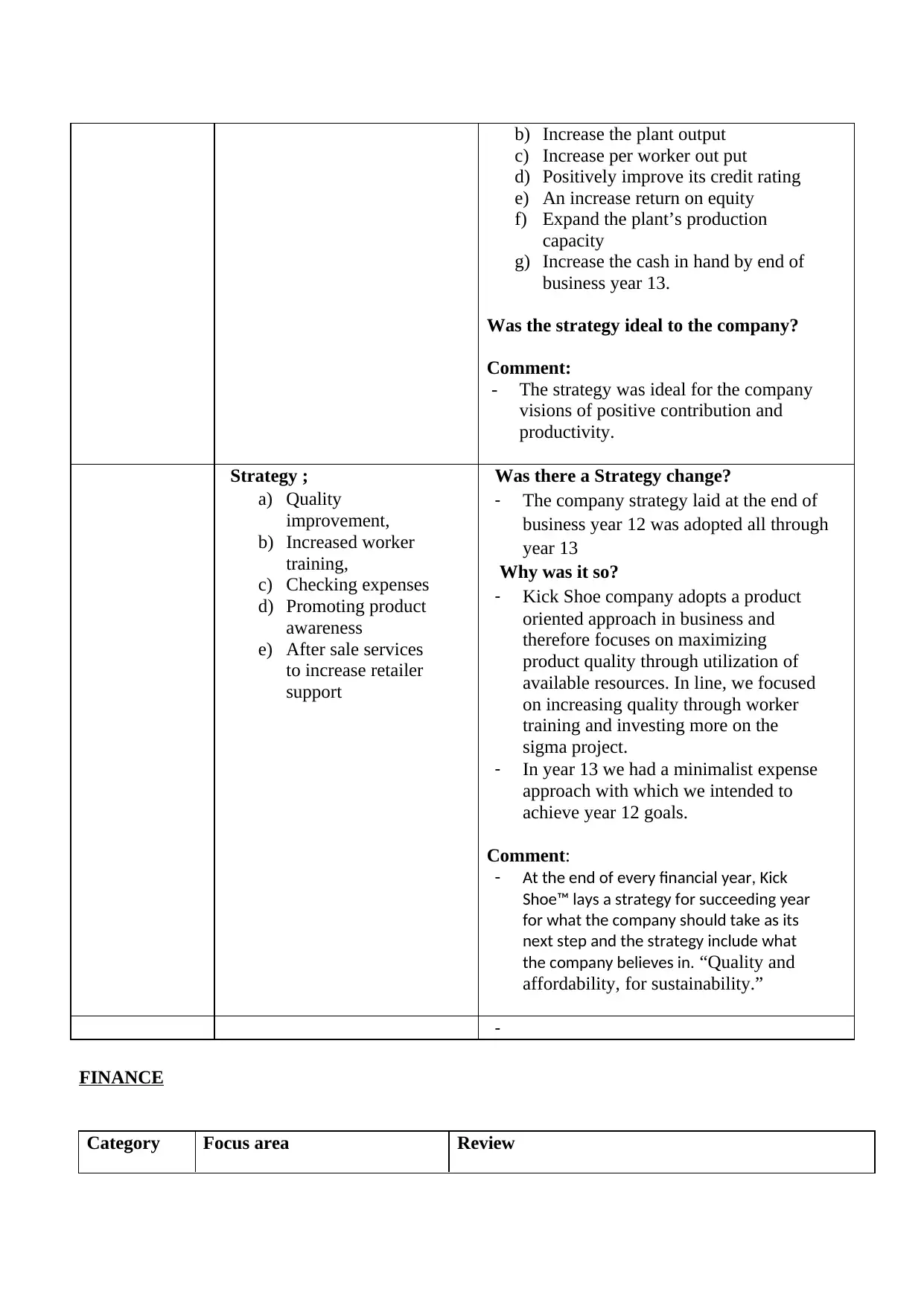
b) Increase the plant output
c) Increase per worker out put
d) Positively improve its credit rating
e) An increase return on equity
f) Expand the plant’s production
capacity
g) Increase the cash in hand by end of
business year 13.
Was the strategy ideal to the company?
Comment:
- The strategy was ideal for the company
visions of positive contribution and
productivity.
Strategy ;
a) Quality
improvement,
b) Increased worker
training,
c) Checking expenses
d) Promoting product
awareness
e) After sale services
to increase retailer
support
Was there a Strategy change?
- The company strategy laid at the end of
business year 12 was adopted all through
year 13
Why was it so?
- Kick Shoe company adopts a product
oriented approach in business and
therefore focuses on maximizing
product quality through utilization of
available resources. In line, we focused
on increasing quality through worker
training and investing more on the
sigma project.
- In year 13 we had a minimalist expense
approach with which we intended to
achieve year 12 goals.
Comment:
- At the end of every financial year, Kick
Shoe™ lays a strategy for succeeding year
for what the company should take as its
next step and the strategy include what
the company believes in. “Quality and
affordability, for sustainability.”
-
FINANCE
Category Focus area Review
c) Increase per worker out put
d) Positively improve its credit rating
e) An increase return on equity
f) Expand the plant’s production
capacity
g) Increase the cash in hand by end of
business year 13.
Was the strategy ideal to the company?
Comment:
- The strategy was ideal for the company
visions of positive contribution and
productivity.
Strategy ;
a) Quality
improvement,
b) Increased worker
training,
c) Checking expenses
d) Promoting product
awareness
e) After sale services
to increase retailer
support
Was there a Strategy change?
- The company strategy laid at the end of
business year 12 was adopted all through
year 13
Why was it so?
- Kick Shoe company adopts a product
oriented approach in business and
therefore focuses on maximizing
product quality through utilization of
available resources. In line, we focused
on increasing quality through worker
training and investing more on the
sigma project.
- In year 13 we had a minimalist expense
approach with which we intended to
achieve year 12 goals.
Comment:
- At the end of every financial year, Kick
Shoe™ lays a strategy for succeeding year
for what the company should take as its
next step and the strategy include what
the company believes in. “Quality and
affordability, for sustainability.”
-
FINANCE
Category Focus area Review
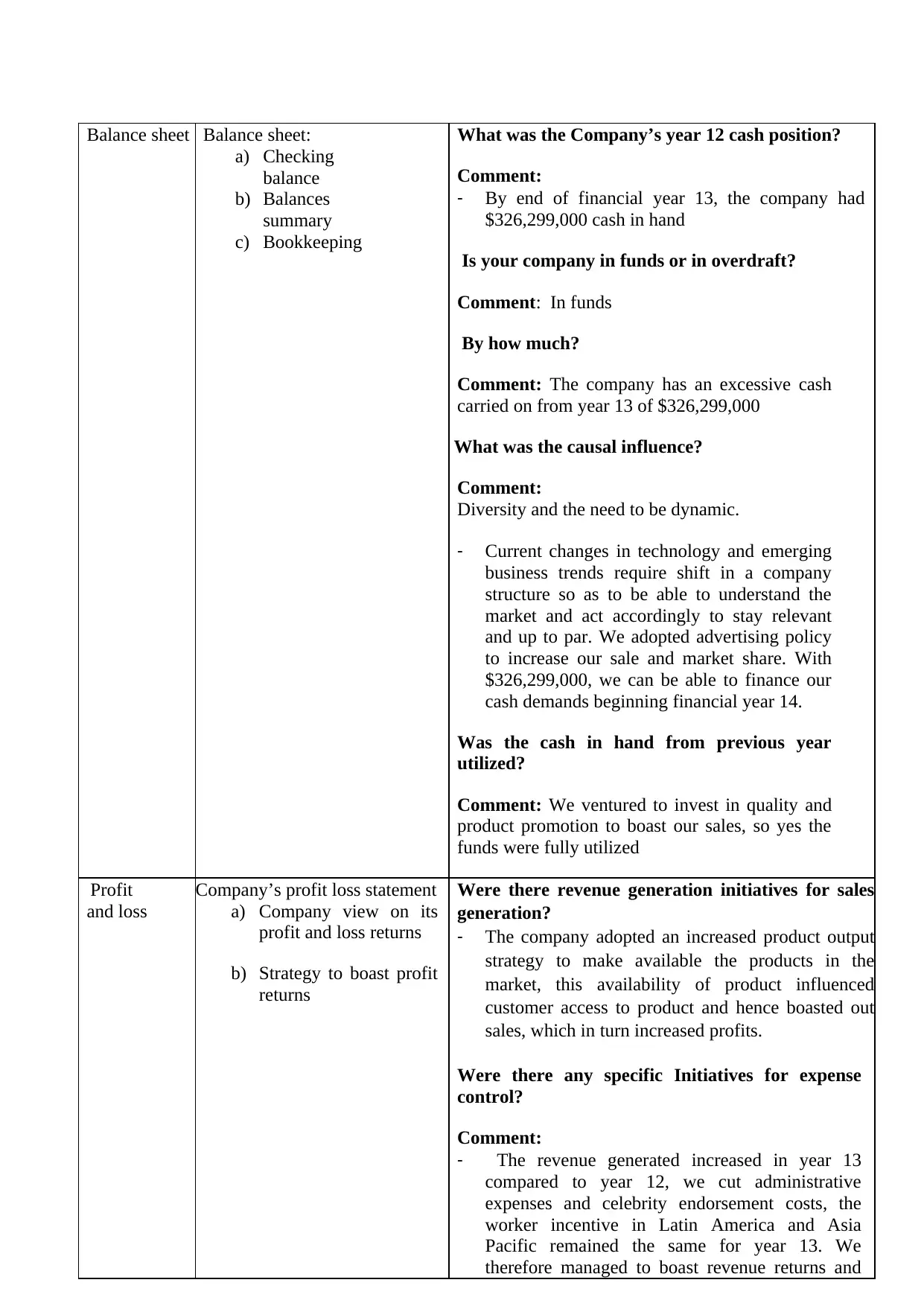
Balance sheet Balance sheet:
a) Checking
balance
b) Balances
summary
c) Bookkeeping
What was the Company’s year 12 cash position?
Comment:
- By end of financial year 13, the company had
$326,299,000 cash in hand
Is your company in funds or in overdraft?
Comment: In funds
By how much?
Comment: The company has an excessive cash
carried on from year 13 of $326,299,000
What was the causal influence?
Comment:
Diversity and the need to be dynamic.
- Current changes in technology and emerging
business trends require shift in a company
structure so as to be able to understand the
market and act accordingly to stay relevant
and up to par. We adopted advertising policy
to increase our sale and market share. With
$326,299,000, we can be able to finance our
cash demands beginning financial year 14.
Was the cash in hand from previous year
utilized?
Comment: We ventured to invest in quality and
product promotion to boast our sales, so yes the
funds were fully utilized
Profit
and loss
Company’s profit loss statement
a) Company view on its
profit and loss returns
b) Strategy to boast profit
returns
Were there revenue generation initiatives for sales
generation?
- The company adopted an increased product output
strategy to make available the products in the
market, this availability of product influenced
customer access to product and hence boasted out
sales, which in turn increased profits.
Were there any specific Initiatives for expense
control?
Comment:
- The revenue generated increased in year 13
compared to year 12, we cut administrative
expenses and celebrity endorsement costs, the
worker incentive in Latin America and Asia
Pacific remained the same for year 13. We
therefore managed to boast revenue returns and
a) Checking
balance
b) Balances
summary
c) Bookkeeping
What was the Company’s year 12 cash position?
Comment:
- By end of financial year 13, the company had
$326,299,000 cash in hand
Is your company in funds or in overdraft?
Comment: In funds
By how much?
Comment: The company has an excessive cash
carried on from year 13 of $326,299,000
What was the causal influence?
Comment:
Diversity and the need to be dynamic.
- Current changes in technology and emerging
business trends require shift in a company
structure so as to be able to understand the
market and act accordingly to stay relevant
and up to par. We adopted advertising policy
to increase our sale and market share. With
$326,299,000, we can be able to finance our
cash demands beginning financial year 14.
Was the cash in hand from previous year
utilized?
Comment: We ventured to invest in quality and
product promotion to boast our sales, so yes the
funds were fully utilized
Profit
and loss
Company’s profit loss statement
a) Company view on its
profit and loss returns
b) Strategy to boast profit
returns
Were there revenue generation initiatives for sales
generation?
- The company adopted an increased product output
strategy to make available the products in the
market, this availability of product influenced
customer access to product and hence boasted out
sales, which in turn increased profits.
Were there any specific Initiatives for expense
control?
Comment:
- The revenue generated increased in year 13
compared to year 12, we cut administrative
expenses and celebrity endorsement costs, the
worker incentive in Latin America and Asia
Pacific remained the same for year 13. We
therefore managed to boast revenue returns and
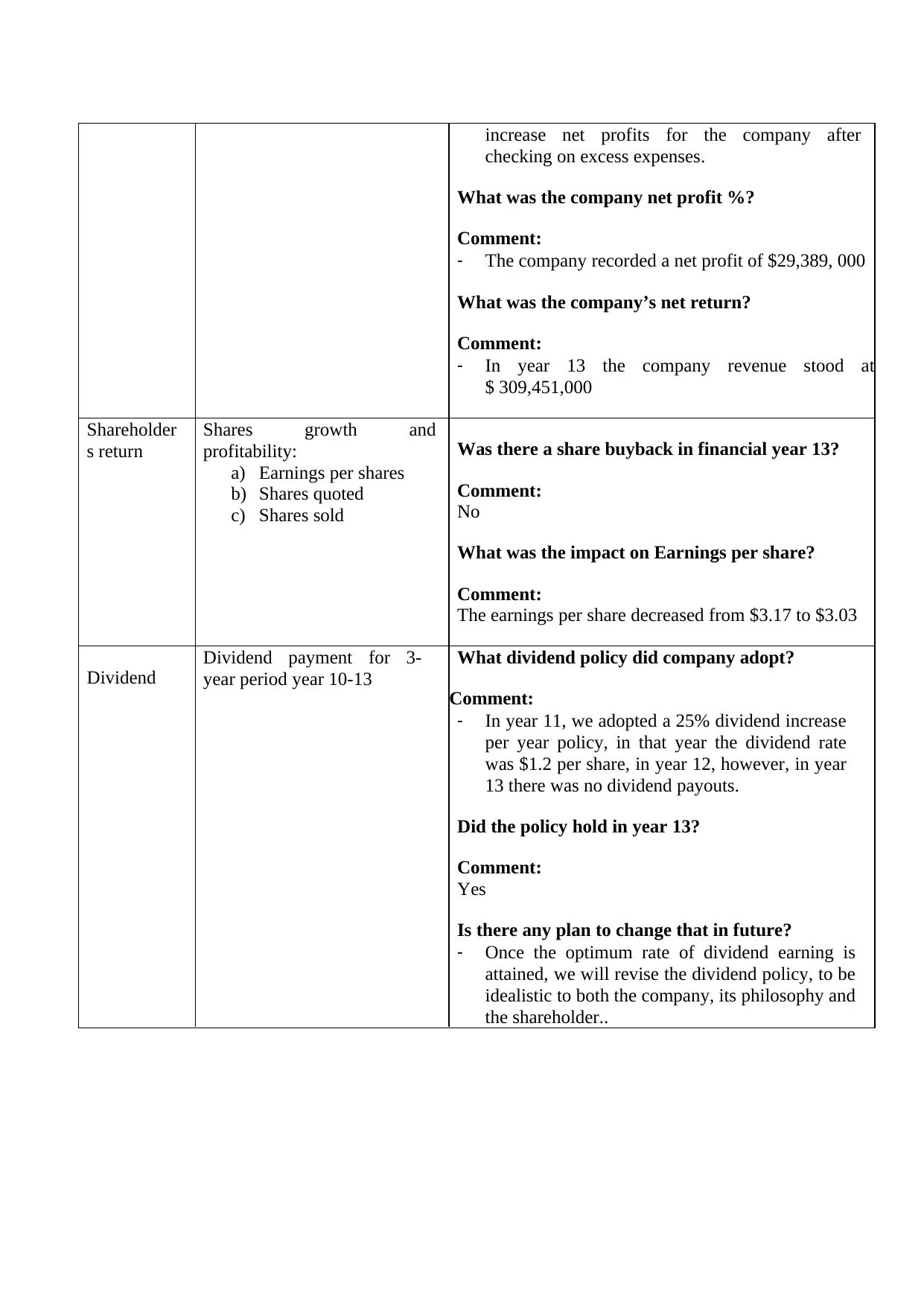
increase net profits for the company after
checking on excess expenses.
What was the company net profit %?
Comment:
- The company recorded a net profit of $29,389, 000
What was the company’s net return?
Comment:
- In year 13 the company revenue stood at
$ 309,451,000
Shareholder
s return
Shares growth and
profitability:
a) Earnings per shares
b) Shares quoted
c) Shares sold
Was there a share buyback in financial year 13?
Comment:
No
What was the impact on Earnings per share?
Comment:
The earnings per share decreased from $3.17 to $3.03
Dividend
Dividend payment for 3-
year period year 10-13
What dividend policy did company adopt?
Comment:
- In year 11, we adopted a 25% dividend increase
per year policy, in that year the dividend rate
was $1.2 per share, in year 12, however, in year
13 there was no dividend payouts.
Did the policy hold in year 13?
Comment:
Yes
Is there any plan to change that in future?
- Once the optimum rate of dividend earning is
attained, we will revise the dividend policy, to be
idealistic to both the company, its philosophy and
the shareholder..
checking on excess expenses.
What was the company net profit %?
Comment:
- The company recorded a net profit of $29,389, 000
What was the company’s net return?
Comment:
- In year 13 the company revenue stood at
$ 309,451,000
Shareholder
s return
Shares growth and
profitability:
a) Earnings per shares
b) Shares quoted
c) Shares sold
Was there a share buyback in financial year 13?
Comment:
No
What was the impact on Earnings per share?
Comment:
The earnings per share decreased from $3.17 to $3.03
Dividend
Dividend payment for 3-
year period year 10-13
What dividend policy did company adopt?
Comment:
- In year 11, we adopted a 25% dividend increase
per year policy, in that year the dividend rate
was $1.2 per share, in year 12, however, in year
13 there was no dividend payouts.
Did the policy hold in year 13?
Comment:
Yes
Is there any plan to change that in future?
- Once the optimum rate of dividend earning is
attained, we will revise the dividend policy, to be
idealistic to both the company, its philosophy and
the shareholder..
Secure Best Marks with AI Grader
Need help grading? Try our AI Grader for instant feedback on your assignments.
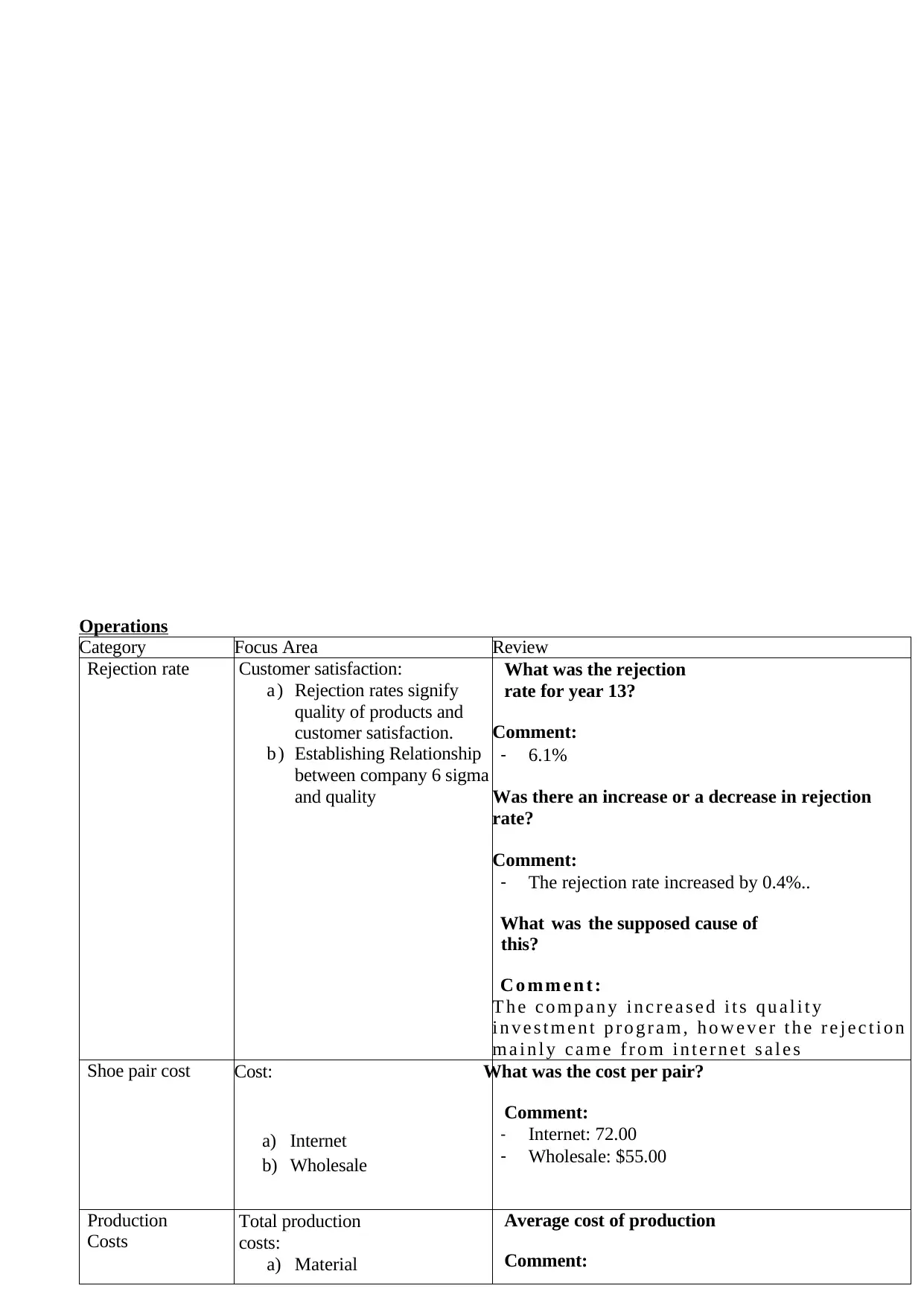
Operations
Category Focus Area Review
Rejection rate Customer satisfaction:
a ) Rejection rates signify
quality of products and
customer satisfaction.
b ) Establishing Relationship
between company 6 sigma
and quality
What was the rejection
rate for year 13?
Comment:
- 6.1%
Was there an increase or a decrease in rejection
rate?
Comment:
- The rejection rate increased by 0.4%..
What was the supposed cause of
this?
C o m m e n t :
T h e c o m p a n y i n c r e a s e d i t s q u a l i t y
i n v e s t m e n t p r o g r a m , h o w e v e r t h e r e j e c t i o n
m a i n l y c a m e f r o m i n t e r n e t s a l e s
Shoe pair cost Cost:
a) Internet
b) Wholesale
What was the cost per pair?
Comment:
- Internet: 72.00
- Wholesale: $55.00
Production
Costs
Total production
costs:
a) Material
Average cost of production
Comment:
Category Focus Area Review
Rejection rate Customer satisfaction:
a ) Rejection rates signify
quality of products and
customer satisfaction.
b ) Establishing Relationship
between company 6 sigma
and quality
What was the rejection
rate for year 13?
Comment:
- 6.1%
Was there an increase or a decrease in rejection
rate?
Comment:
- The rejection rate increased by 0.4%..
What was the supposed cause of
this?
C o m m e n t :
T h e c o m p a n y i n c r e a s e d i t s q u a l i t y
i n v e s t m e n t p r o g r a m , h o w e v e r t h e r e j e c t i o n
m a i n l y c a m e f r o m i n t e r n e t s a l e s
Shoe pair cost Cost:
a) Internet
b) Wholesale
What was the cost per pair?
Comment:
- Internet: 72.00
- Wholesale: $55.00
Production
Costs
Total production
costs:
a) Material
Average cost of production
Comment:
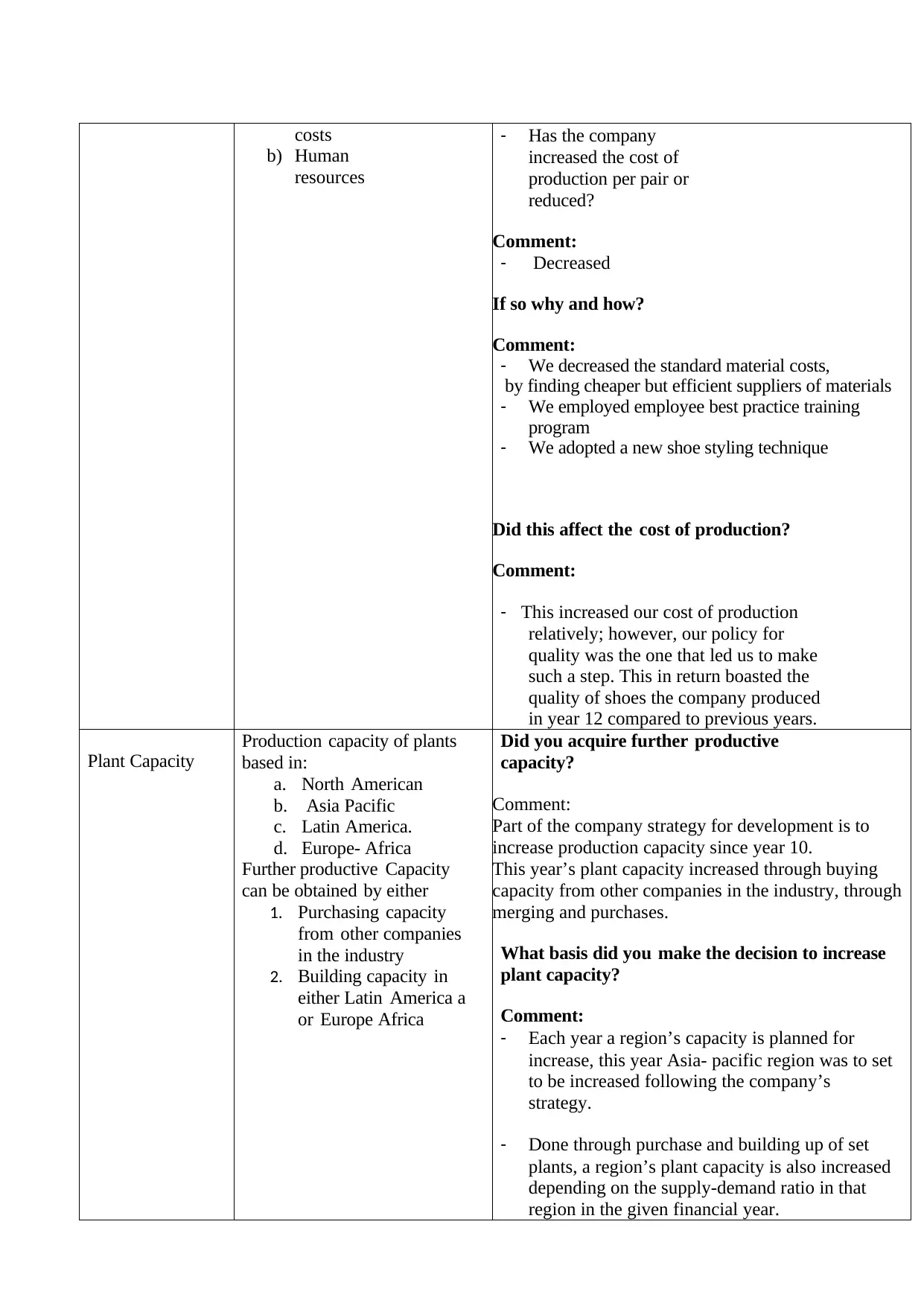
costs
b) Human
resources
- Has the company
increased the cost of
production per pair or
reduced?
Comment:
- Decreased
If so why and how?
Comment:
- We decreased the standard material costs,
by finding cheaper but efficient suppliers of materials
- We employed employee best practice training
program
- We adopted a new shoe styling technique
Did this affect the cost of production?
Comment:
- This increased our cost of production
relatively; however, our policy for
quality was the one that led us to make
such a step. This in return boasted the
quality of shoes the company produced
in year 12 compared to previous years.
Plant Capacity
Production capacity of plants
based in:
a. North American
b. Asia Pacific
c. Latin America.
d. Europe- Africa
Further productive Capacity
can be obtained by either
1. Purchasing capacity
from other companies
in the industry
2. Building capacity in
either Latin America a
or Europe Africa
Did you acquire further productive
capacity?
Comment:
Part of the company strategy for development is to
increase production capacity since year 10.
This year’s plant capacity increased through buying
capacity from other companies in the industry, through
merging and purchases.
What basis did you make the decision to increase
plant capacity?
Comment:
- Each year a region’s capacity is planned for
increase, this year Asia- pacific region was to set
to be increased following the company’s
strategy.
- Done through purchase and building up of set
plants, a region’s plant capacity is also increased
depending on the supply-demand ratio in that
region in the given financial year.
b) Human
resources
- Has the company
increased the cost of
production per pair or
reduced?
Comment:
- Decreased
If so why and how?
Comment:
- We decreased the standard material costs,
by finding cheaper but efficient suppliers of materials
- We employed employee best practice training
program
- We adopted a new shoe styling technique
Did this affect the cost of production?
Comment:
- This increased our cost of production
relatively; however, our policy for
quality was the one that led us to make
such a step. This in return boasted the
quality of shoes the company produced
in year 12 compared to previous years.
Plant Capacity
Production capacity of plants
based in:
a. North American
b. Asia Pacific
c. Latin America.
d. Europe- Africa
Further productive Capacity
can be obtained by either
1. Purchasing capacity
from other companies
in the industry
2. Building capacity in
either Latin America a
or Europe Africa
Did you acquire further productive
capacity?
Comment:
Part of the company strategy for development is to
increase production capacity since year 10.
This year’s plant capacity increased through buying
capacity from other companies in the industry, through
merging and purchases.
What basis did you make the decision to increase
plant capacity?
Comment:
- Each year a region’s capacity is planned for
increase, this year Asia- pacific region was to set
to be increased following the company’s
strategy.
- Done through purchase and building up of set
plants, a region’s plant capacity is also increased
depending on the supply-demand ratio in that
region in the given financial year.

MARKETING
Category Focus Area Review
Pricing Pricing strategy for year 13:
a) Across the different
distribution channels
b) Internet
c) Wholesale
For each of branded product
Were there differences in
prices for the products in
the distribution channels?
Comment:
The company distributed its
products through its
production channels in
different prices.
- Wholesale sales in all
regions:
Year 12: $55.73 per pair
Year 13: $61.98 per pair
- Internet Sales:
Year 12: $70.25 per pair
Year 13: $73.34 per pair
Was there a rebate offered for
retailers? How much?
Comment:
- Year 13: $3.0 rebate offer
per pair
Advertising What were the marketing
ventures for the company?
a) Mainstream media
advertising
b) Celebrity
endorsement
What was the growth in
marketing costs and did
this have an impact on the
growth in sales. i.e.: was
there a correlation to the
revenue line for the
business?
Comment:
- The company invested in
consumer awareness, this
in return saw an increase
in the gross sales made in
the year 13.
Celebrity Endorsements Relationship between Did you use celebrities as
Category Focus Area Review
Pricing Pricing strategy for year 13:
a) Across the different
distribution channels
b) Internet
c) Wholesale
For each of branded product
Were there differences in
prices for the products in
the distribution channels?
Comment:
The company distributed its
products through its
production channels in
different prices.
- Wholesale sales in all
regions:
Year 12: $55.73 per pair
Year 13: $61.98 per pair
- Internet Sales:
Year 12: $70.25 per pair
Year 13: $73.34 per pair
Was there a rebate offered for
retailers? How much?
Comment:
- Year 13: $3.0 rebate offer
per pair
Advertising What were the marketing
ventures for the company?
a) Mainstream media
advertising
b) Celebrity
endorsement
What was the growth in
marketing costs and did
this have an impact on the
growth in sales. i.e.: was
there a correlation to the
revenue line for the
business?
Comment:
- The company invested in
consumer awareness, this
in return saw an increase
in the gross sales made in
the year 13.
Celebrity Endorsements Relationship between Did you use celebrities as
Paraphrase This Document
Need a fresh take? Get an instant paraphrase of this document with our AI Paraphraser
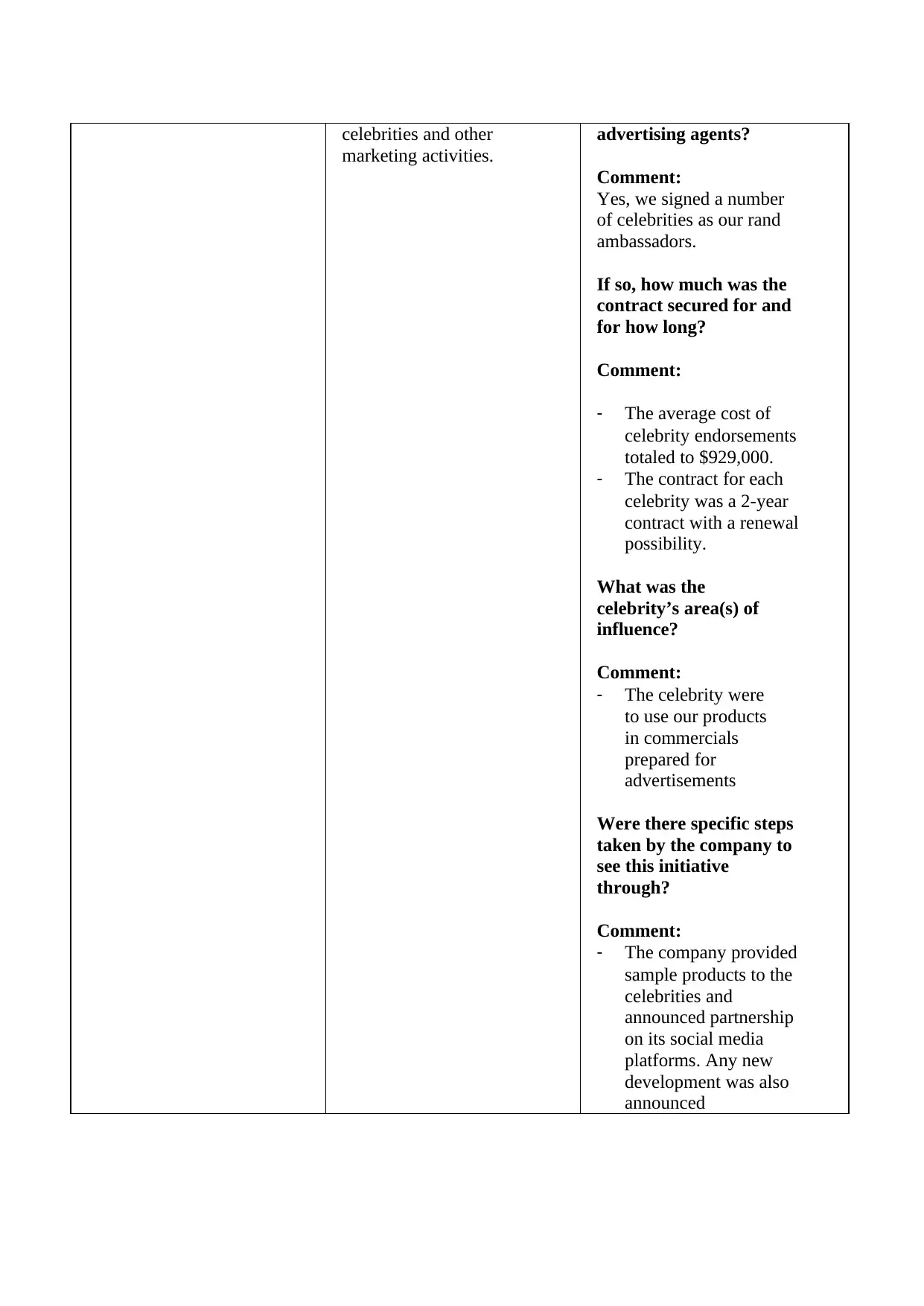
celebrities and other
marketing activities.
advertising agents?
Comment:
Yes, we signed a number
of celebrities as our rand
ambassadors.
If so, how much was the
contract secured for and
for how long?
Comment:
- The average cost of
celebrity endorsements
totaled to $929,000.
- The contract for each
celebrity was a 2-year
contract with a renewal
possibility.
What was the
celebrity’s area(s) of
influence?
Comment:
- The celebrity were
to use our products
in commercials
prepared for
advertisements
Were there specific steps
taken by the company to
see this initiative
through?
Comment:
- The company provided
sample products to the
celebrities and
announced partnership
on its social media
platforms. Any new
development was also
announced
marketing activities.
advertising agents?
Comment:
Yes, we signed a number
of celebrities as our rand
ambassadors.
If so, how much was the
contract secured for and
for how long?
Comment:
- The average cost of
celebrity endorsements
totaled to $929,000.
- The contract for each
celebrity was a 2-year
contract with a renewal
possibility.
What was the
celebrity’s area(s) of
influence?
Comment:
- The celebrity were
to use our products
in commercials
prepared for
advertisements
Were there specific steps
taken by the company to
see this initiative
through?
Comment:
- The company provided
sample products to the
celebrities and
announced partnership
on its social media
platforms. Any new
development was also
announced
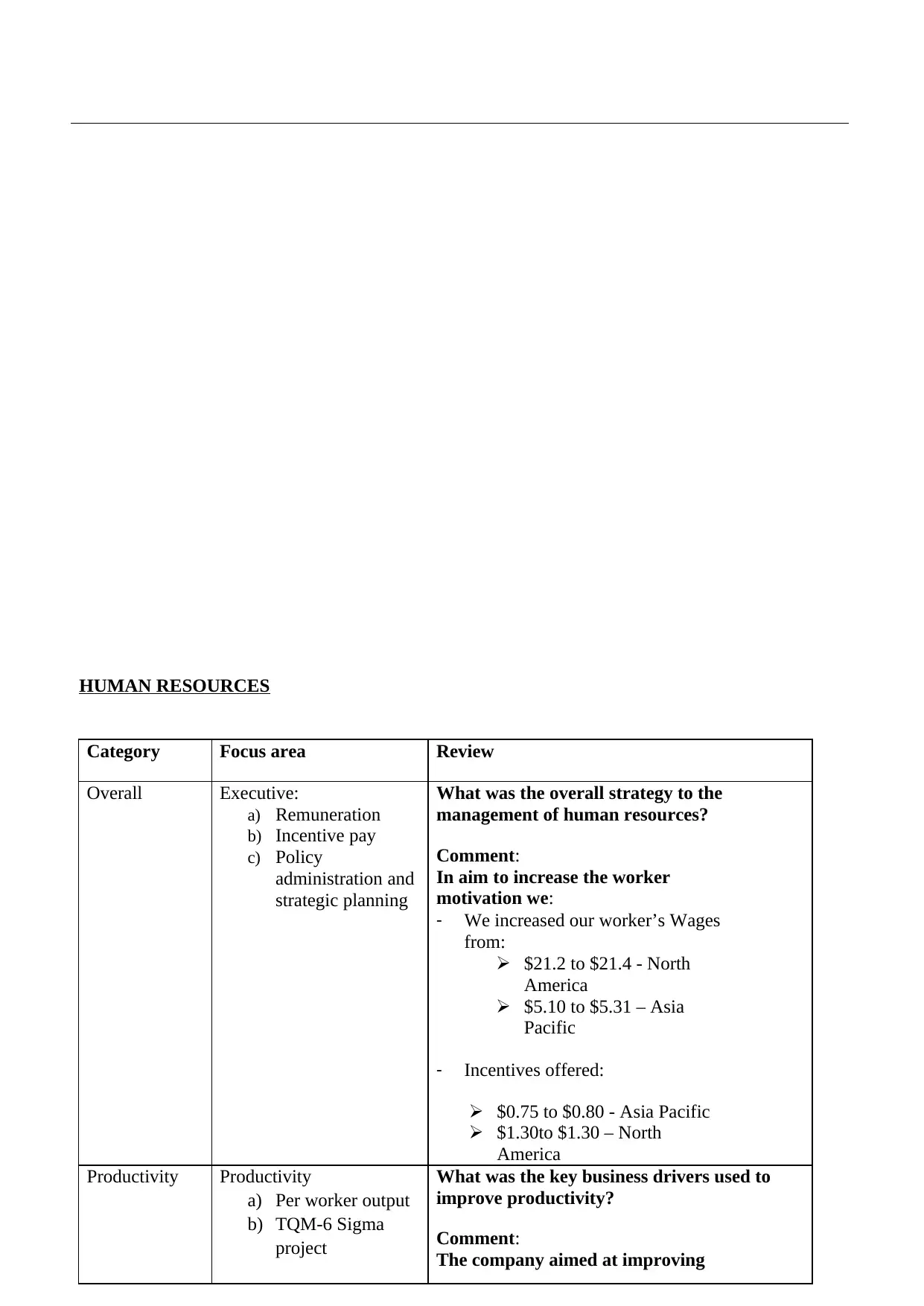
HUMAN RESOURCES
Category Focus area Review
Overall Executive:
a) Remuneration
b) Incentive pay
c) Policy
administration and
strategic planning
What was the overall strategy to the
management of human resources?
Comment:
In aim to increase the worker
motivation we:
- We increased our worker’s Wages
from:
$21.2 to $21.4 - North
America
$5.10 to $5.31 – Asia
Pacific
- Incentives offered:
$0.75 to $0.80 - Asia Pacific
$1.30to $1.30 – North
America
Productivity Productivity
a) Per worker output
b) TQM-6 Sigma
project
What was the key business drivers used to
improve productivity?
Comment:
The company aimed at improving
Category Focus area Review
Overall Executive:
a) Remuneration
b) Incentive pay
c) Policy
administration and
strategic planning
What was the overall strategy to the
management of human resources?
Comment:
In aim to increase the worker
motivation we:
- We increased our worker’s Wages
from:
$21.2 to $21.4 - North
America
$5.10 to $5.31 – Asia
Pacific
- Incentives offered:
$0.75 to $0.80 - Asia Pacific
$1.30to $1.30 – North
America
Productivity Productivity
a) Per worker output
b) TQM-6 Sigma
project
What was the key business drivers used to
improve productivity?
Comment:
The company aimed at improving
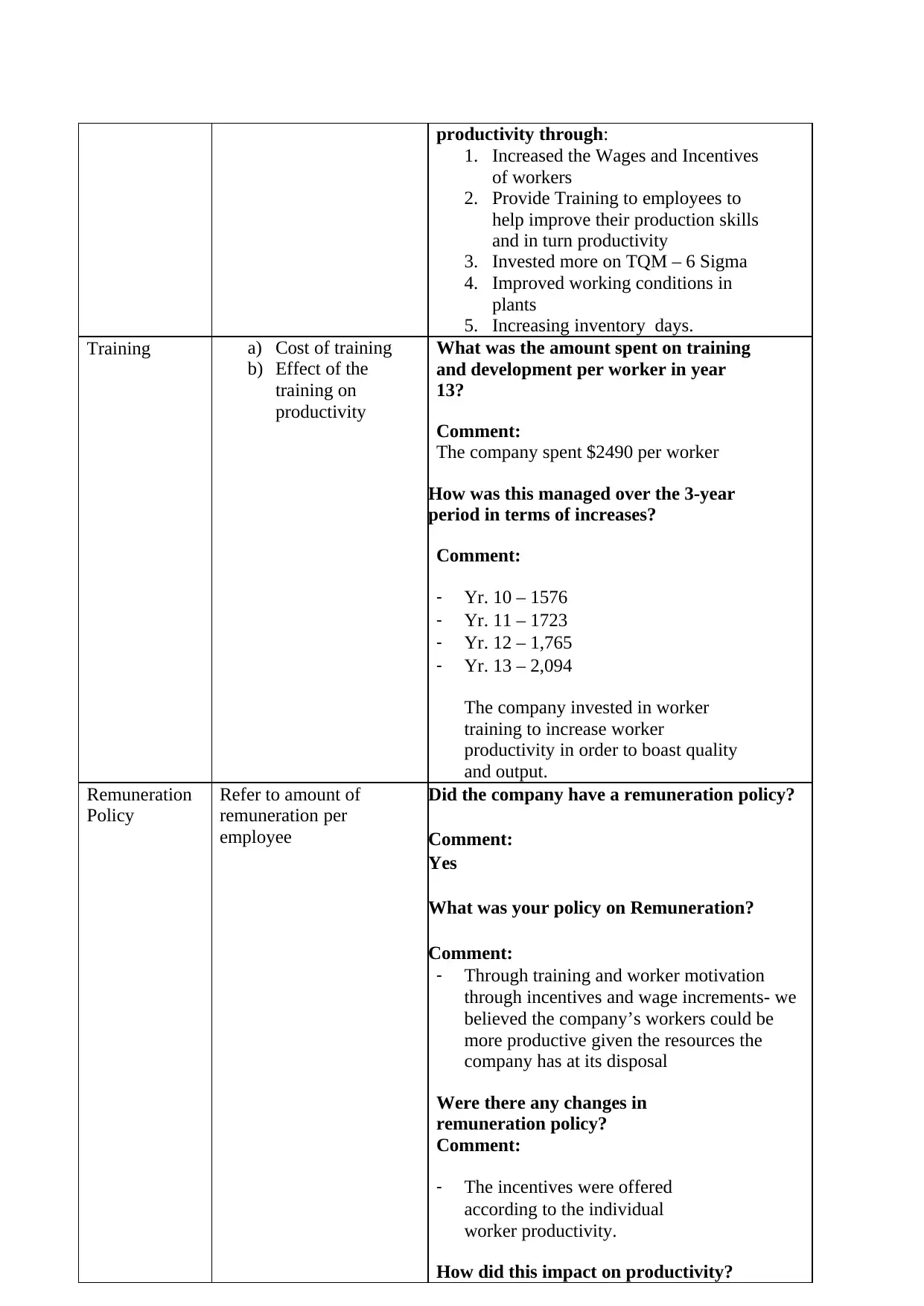
productivity through:
1. Increased the Wages and Incentives
of workers
2. Provide Training to employees to
help improve their production skills
and in turn productivity
3. Invested more on TQM – 6 Sigma
4. Improved working conditions in
plants
5. Increasing inventory days.
Training a) Cost of training
b) Effect of the
training on
productivity
What was the amount spent on training
and development per worker in year
13?
Comment:
The company spent $2490 per worker
How was this managed over the 3-year
period in terms of increases?
Comment:
- Yr. 10 – 1576
- Yr. 11 – 1723
- Yr. 12 – 1,765
- Yr. 13 – 2,094
The company invested in worker
training to increase worker
productivity in order to boast quality
and output.
Remuneration
Policy
Refer to amount of
remuneration per
employee
Did the company have a remuneration policy?
Comment:
Yes
What was your policy on Remuneration?
Comment:
- Through training and worker motivation
through incentives and wage increments- we
believed the company’s workers could be
more productive given the resources the
company has at its disposal
Were there any changes in
remuneration policy?
Comment:
- The incentives were offered
according to the individual
worker productivity.
How did this impact on productivity?
1. Increased the Wages and Incentives
of workers
2. Provide Training to employees to
help improve their production skills
and in turn productivity
3. Invested more on TQM – 6 Sigma
4. Improved working conditions in
plants
5. Increasing inventory days.
Training a) Cost of training
b) Effect of the
training on
productivity
What was the amount spent on training
and development per worker in year
13?
Comment:
The company spent $2490 per worker
How was this managed over the 3-year
period in terms of increases?
Comment:
- Yr. 10 – 1576
- Yr. 11 – 1723
- Yr. 12 – 1,765
- Yr. 13 – 2,094
The company invested in worker
training to increase worker
productivity in order to boast quality
and output.
Remuneration
Policy
Refer to amount of
remuneration per
employee
Did the company have a remuneration policy?
Comment:
Yes
What was your policy on Remuneration?
Comment:
- Through training and worker motivation
through incentives and wage increments- we
believed the company’s workers could be
more productive given the resources the
company has at its disposal
Were there any changes in
remuneration policy?
Comment:
- The incentives were offered
according to the individual
worker productivity.
How did this impact on productivity?
Secure Best Marks with AI Grader
Need help grading? Try our AI Grader for instant feedback on your assignments.

Comment:
- There was a record of decreased productivity
in production across all regions in year 13. i.e.
From $6,579 in year 12 to $6,564 in year 13
- There was a record of decreased productivity
in production across all regions in year 13. i.e.
From $6,579 in year 12 to $6,564 in year 13
1 out of 11
Your All-in-One AI-Powered Toolkit for Academic Success.
+13062052269
info@desklib.com
Available 24*7 on WhatsApp / Email
![[object Object]](/_next/static/media/star-bottom.7253800d.svg)
Unlock your academic potential
© 2024 | Zucol Services PVT LTD | All rights reserved.





